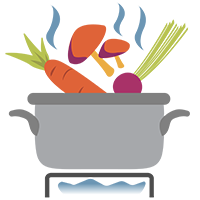Chocolate Chia-nanza Pudding

Chocolate Chia-nanza Pudding
This chocolate banana chia pudding is a nutritious and delicious breakfast, snack, or dessert option for kids. It's packed with fiber, protein, and healthy fats, making it a great way to start the day or refuel after a long day of play.
Happy & Healthy Cooking,
Fun-Da-Mentals Kitchen Skills
- chill :
to cool, not freeze, food or drink by putting it on ice or in a refrigerator.
- mash :
to reduce food, like potatoes or bananas, to a soft, pulpy state by beating or pressure.
- measure :
to calculate the specific amount of an ingredient required using a measuring tool (like measuring cups or spoons).
Equipment Checklist
- Medium bowl + lid (or plastic wrap)
- Dry measuring cups
- Liquid measuring cup
- Measuring spoons
- Whisk
Ingredients
Chocolate Chia-nanza Pudding
- 1 ripe banana
- 1/4 cup chia seeds
- 1 C milk **(for DAIRY ALLERGY sub dairy-free/nut-free milk)**
- 1 T cocoa powder **(for CHOCOLATE ALLERGY sub carob powder)**
- 1 T agave nectar/honey/maple syrup
- 1 pinch salt
- ice (if no refrigerator present)
Food Allergen Substitutions
Chocolate Chia-nanza Pudding
- Dairy: Substitute dairy-free/nut-free milk.
- Chocolate: Substitute carob powder for cocoa powder.
Instructions
Chocolate Chia-nanza Pudding
intro
If serving this dessert with a meal, start it first to give it time to gel. It's a no-cook pudding made by mixing a few ingredients in a bowl and letting chia seeds do their thing. The texture is similar to tapioca pudding, but it has way less added sugar, way more nutrition (chia seeds are packed with amino acids and are a complete protein!), and—the best part—is way easier to make!
mash + measure
In a medium-sized bowl, have kids mash 1 banana really well. Then measure and whisk together 1/4 cup chia seeds, 1 cup milk, 1 tablespoon cocoa powder, 1 tablespoon agave nectar, and **1 pinch of salt into the same bowl, until all is smooth and combined.
cover + chill + wait
Cover the bowl with plastic wrap or a lid and set aside in a refrigerator or on a bag of ice for at least 30 minutes and up to 2 hours to allow the chia seeds to absorb the liquid and thicken the pudding.
stir + enjoy
Once the pudding is thick and set, give it a good stir to ensure no lumps. If it's too thick, you can add a splash of milk to thin it out. Enjoy!

Hi! I'm a Chia Seed!
"Chia seeds may make you think of the terra cotta chia planters of animals and people that sprout fur and hair from chia seeds, first sold in 1977. We're a whole lot more than that, though. We're considered a 'superfood'! We add fiber and protein to foods, thicken sauces, and replace eggs in baked foods!"
History & Etymology
- The chia plant is native to central and southern Mexico and Guatemala. Records indicate chia seeds were used as a food source as far back as 3500 BCE. It was the third most important crop for the Aztecs, who recognized it as a "superfood" and prized it so highly that it was often used as currency.
- Aztec warriors and runners are believed to have sustained themselves for an entire day on just a tablespoon of chia.
- After the Spanish conquest, chia seeds nearly disappeared as the Spaniards banned foods that were linked to Aztec religion or tradition and virtually wiped out the complex agricultural system established by the Aztecs to grow foods that were popular in Spain instead.
- The word "chia" is derived from the Nahuatl word "chian," which means "oily."
Anatomy
- The chia plant (Salvia hispanica) is an annual flowering plant in the Lamiaceae or mint family. It is a pseudocereal or pseudograin, meaning it is a non-grass used similarly to cereal grains.
- The plant can grow to over five feet and has purple or white flowers. They are grown for their edible, dark brown, oval seeds, which are 1 millimeter or 1/32 inch in diameter. The seeds are hydrophilic, meaning they can be mixed with or dissolved in water.
How to Store and Use
- Because of their natural antioxidants, chia seeds do not spoil easily and can be stored unopened for 2 to 4 years on the shelf or 3 to 5 years in the refrigerator or freezer. They can be kept in an airtight container for 1 to 2 years once they are opened.
- Chia seeds absorb up to 12 times their weight in whatever liquid they are soaking in. This little trick makes them a great thickening agent. Use whole seeds in hearty, chunky sauces. Need to thicken up a thinner, delicate sauce? Add a few tablespoons of whole chia seeds to a coffee grinder to create chia powder that will still thicken but be invisible in your sauce.
- Add chia seeds to smoothies, yogurt, oatmeal, granola, or other cereal. Include them in bread, muffins, cakes, and cookies. Sprinkle chia seeds in salads, salad dressings, and soups.
- Chia pudding is made by soaking chia seeds overnight in milk or juice. It is a healthy breakfast or snack.
- The popular Mexican drink "chia fresca" is made by soaking chia seeds in water until they become gelatinous and then adding sugar and lemon or lime juice.
Nutrition
- Chia seeds are rich in omega-3 fatty acids and antioxidants. One tablespoon has 5 grams of fiber and 2 grams of protein. They have 15 percent of the daily value of magnesium and phosphorus and 9 percent of the daily value of calcium.
- Chia seeds are a good source of electrolytes, which help with muscle function, and a moderate source of zinc, which helps with immune function.
Let's Learn About Mexico!

- Officially, Mexico's name is "The United Mexican States." It is one of several countries and territories in North America, including Canada and the United States of America.
- Spanish is Mexico's national language, and Mexico is the largest Spanish-speaking country in the world. Mexican people didn't always speak Spanish, though. For thousands of years, Native Americans lived there and built great cities. The people had advanced language, education, and calendar systems, and they had very clever ways of raising food. Mexico is also the country with the largest number of native American speakers in North America.
- The capital of Mexico is Mexico City. Mexican legend says that Aztec leaders were told to build their great city of Tenochtitlan at the site where they saw an eagle sitting on a nopal cactus with a snake in its beak. That image is in the center of Mexico's flag. The Aztecs built their city on an island in the middle of a lake. The ruins of Tenochtitlan are at the center of Mexico City and still sit on top of a lake! As water is pumped out to serve the needs of the city's growing population, the city has been sinking at a rate of 6 to 8 inches per year.
- Indigenous Mexican people included the Aztecs in the central interior of the country, the Mayans of the Yucatan peninsula, and the Zapotec of the south. Spanish explorers landed in Mexico in the early 1500s, and they ruled Mexico for over 300 years. During this time of colonization, Mexico's Mesoamerican civilizations mixed with European culture.
- Before the arrival of Spaniards, native Mexican food primarily consisted of corn, beans, peppers, tomatoes, sweet potatoes, squash, and herbs. Indigenous people occasionally hunted and added wild turkey, rabbit, deer, and quail to their largely vegetarian diets. Native royalty sipped chocolate drinks. Europeans introduced cattle, sheep, pigs, goats, chickens, sugarcane, and wheat to Mexico upon their arrival.
- Mexican cuisine uses chili peppers to give it its distinct flavor. Jalapeños, poblanos, and serrano peppers are commonly used in Mexican dishes. Dishes that include mole, a sauce made of dark chocolate, chili peppers, cinnamon, and other spices, may be served on special occasions, such as Día de los Muertos.
What is it like to be a kid in Mexico?
- Mexican children may live near the ocean or the gulf, in the desert, or in the mountains.
- Kids often live with extended family, including grandparents. Their full names include their father's and their mother's.
- Most kids speak Spanish, but Mexico also recognizes 68 native languages.
- They attend school from September through June. Large schools have two shifts—one group in the morning and one in the afternoon. Students are usually required to wear uniforms.
- They may play soccer, baseball, and other sports. Jumping rope and other outdoor games are very popular. They might play a game similar to bingo called Lotería. It is played with picture cards and songs.
- Corn tortillas are a staple for kids, along with beans and rice. Dishes that include mole, a sauce often made of dark chocolate, chili peppers, cinnamon, and other spices, may be served on special occasions.
- A popular family holiday is Día de los Muertos (Day of the Dead), a celebration to remember and honor a family's ancestors. Family members decorate the graves of their relatives who have passed on. Typical foods served for this holiday include empanadas, tamales, pan de muertos (a sweet bread in which a ring with a tiny plastic skeleton is hidden), and calaveras de azucar (sugar candy skulls).




